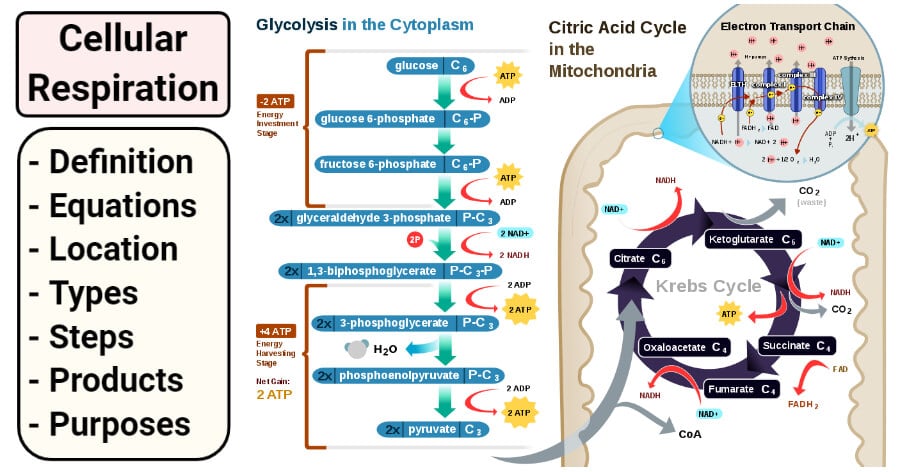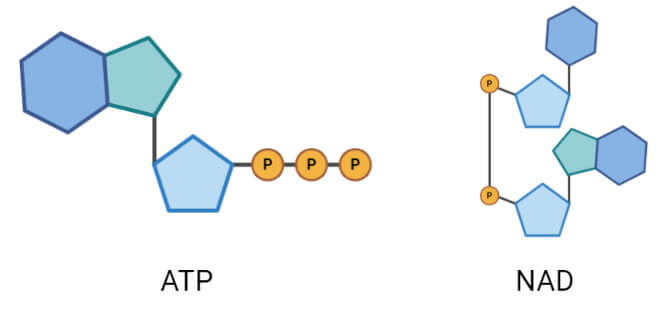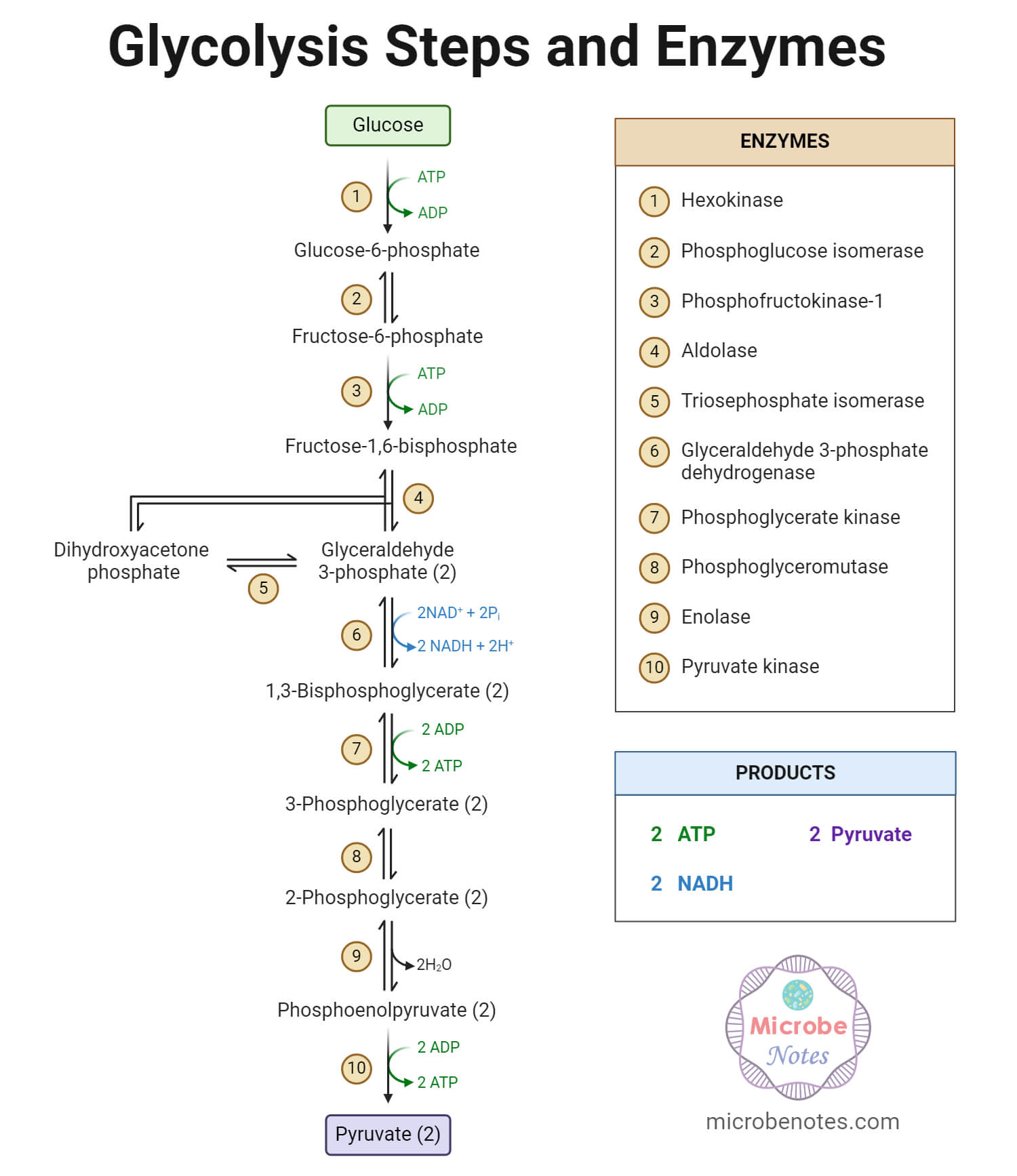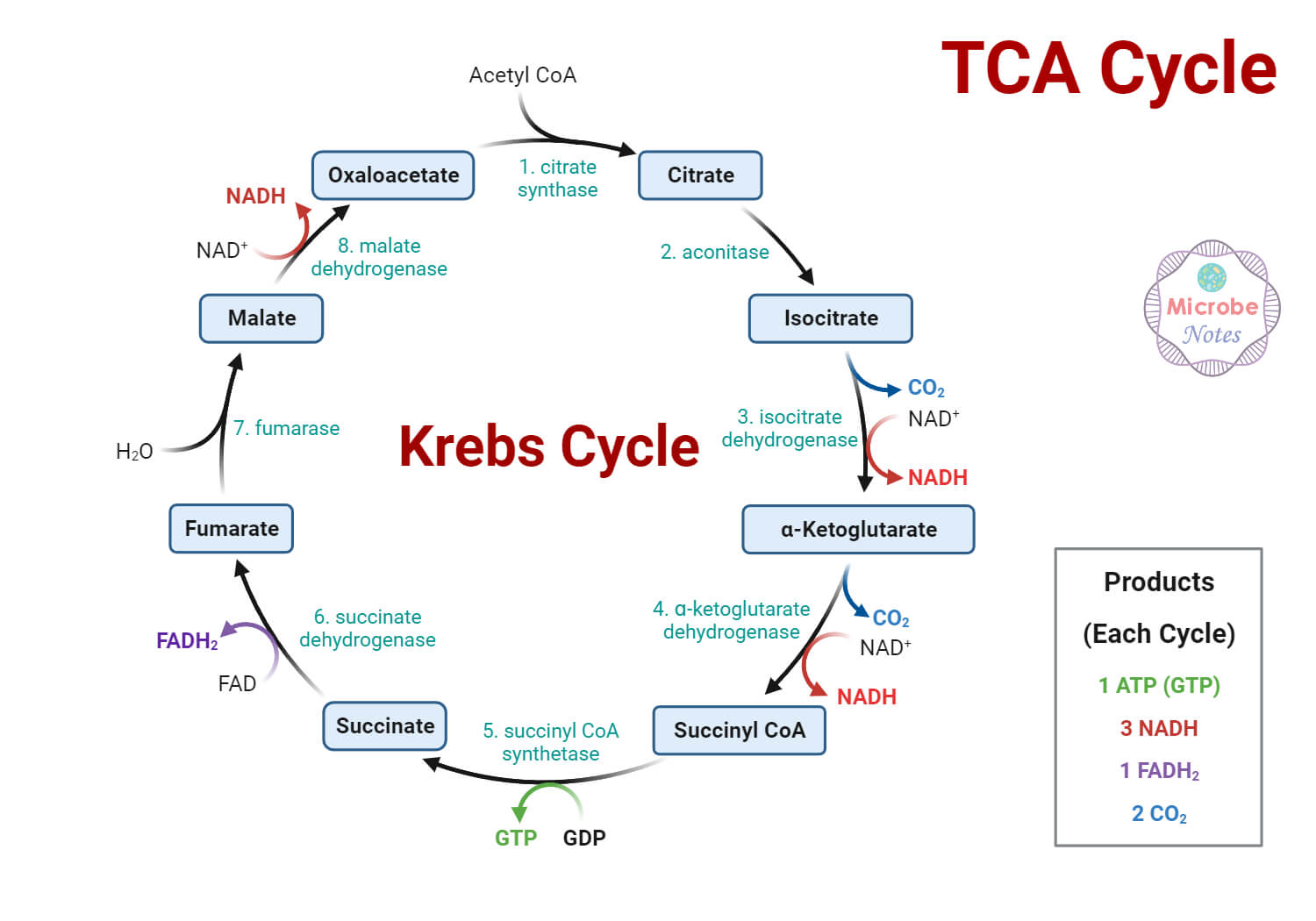Cellular respiration is a metabolic process consisting of a series of steps to convert chemical energy (sugar) into a usable form of energy (ATP) in the cell.
- The reactions involved in cellular respiration are catabolic reactions that involve the breakdown of larger organic molecules into smaller forms.
- The overall process of cellular respiration takes place in a number of steps that are specialized for the degradation of specific molecules.
- Cellular respiration is a basis of life that occurs in all living forms. In most multicellular organisms, cellular respiration occurs in the form of aerobic respiration.
- The process of cellular respiration involves the breakdown of high energy bonds, which release energy in the form of ATP.
- Technically, cellular respiration is a combustion reaction, but the process in the cell occurs in a slow controlled manner to release energy via a series of reactions.
- Most of the reactions in cellular respiration are redox reactions in the presence of strong oxidizing agents like molecular oxygen.
- The chemical energy produced during cellular respiration is stored in the form of ATP which releases energy by the breaking of the bond of the third phosphate group during processes like biosynthesis, locomotion, and active transport of molecules.
- Different biomolecules and structures are involved during the process of cellular respiration.
- Similarly, a different set of enzymes catalyze different steps of cellular respiration, all of which are found within the cell.

Image Source: RegisFrey.
What is ATP?
- Adenosine Triphosphate (ATP) is an inorganic compound that acts as an energy-carrying molecule by capturing energy produced from chemical reactions.
- ATP is a nucleotide molecule consisting of three main structural units; nitrogenous base, adenine, sugar unit, ribose, and three phosphate groups bound to the ribose backbone.
- ATP doesn’t act as a storage unit for energy like carbohydrates and proteins but acts as a shuttle to release energy during energy-consuming activities.
- The release of energy by ATP occurs as a result of the breaking down of the phosphate bonds to form ADP or AMP molecules.
- Most of the ATP in the cell is synthesized in the mitochondria as it is considered the powerhouse of the cell, while some ATP might be produced in the cytoplasm.

Interesting Science Videos
What is NAD?
- Nicotinamide Adenine Diphosphate (NAD) is a coenzyme that plays a central role in cellular respiration as it acts as a means of electron transport.
- The molecule consists of two nucleotide units where one contains adenine as the nucleobase, and the other contains the nicotinamide unit. Besides, two phosphate groups are attached to the nucleotide units.
- NAD exits in two different forms based on its oxidation state NAD+ is the oxidized state and NADH is the reduced state.
- NAD is involved in redox reactions where it becomes reduced by accepting electrons and oxidizes by donating those electrons to other molecules.
- It is synthesized in the body from smaller units of amino acids like tryptophan and aspartic acid.
What is FAD?
- Flavin Adenine Dinucleotide (FAD) is a metabolic coenzyme that is involved in various enzymatic reactions in the body as an electron carrier.
- FAD is similar in structure to NAD with two nucleotide units, where one consists of adenine as the nitrogen base whereas the other consists of flavin units.
- FAD is synthesized in the body from riboflavin and two molecules of ATP. The phosphorylation of riboflavin by ATP results in the formation of FMN. The transfer of an AMP unit from ATP then results in the formation of FAD.
- In the case of cellular respiration, the FAD involved exists in two oxidation states; FADH and FADH2.
- Due to their multiple oxidation states, FAD molecules are involved in the transfer of electrons from one molecule to another.
Location of Cellular Respiration
- Cellular respiration takes place in individual cells to produce energy for the particular cell.
- Within the eukaryotic cell, Cellular Respiration begins in the cytoplasm. The first step of cellular respiration, glycolysis, takes place in the cytoplasm as the enzymes required for glycolysis are present in the cytoplasm.
- The end results of the glycolysis steps are transported into the mitochondria of the cell where the rest of the steps of cellular respiration take place.
- The next steps, like the citric acid cycle and oxidative phosphorylation, occur in the outer and inner membrane of the mitochondria.
- In the case of prokaryotic cells, however, all the steps of cellular respiration occur in the cytoplasm as they do not have defined cell organelles.
Cellular Respiration Equations
The steps and reactions involved in cellular respiration might be different in different types of cellular respiration.
Aerobic respiration equation
- In aerobic respiration, one glucose molecule combines with an oxygen molecule and ADP to form carbon dioxide, water, and energy. Aerobic respiration is the most efficient pathway of cellular respiration that produces the largest number of ATPs.
- The overall equation of aerobic respiration is:
C6H12O6 + 6O2 + 36ADP + 36Pi → 6CO2 + 6H2O + 36ATP
Anaerobic respiration equation
- In anaerobic respiration, the equation involved depends on the pathway utilized. Anaerobic pathways are less efficient than aerobic respiration as they produce a lesser number of ATPs.
- In alcoholic fermentation, one molecule of glucose degrades into ethyl alcohol, carbon dioxide, and energy. The process takes place in the absence of oxygen.
- The overall equation of anaerobic respiration is:
C6H12O6 + 2ADP + 2Pi → 2C2H5OH + 2CO2 + 2ATP
- In lactic acid fermentation, one molecule of glucose is degraded into lactic acid and energy. This respiration also occurs in the absence of oxygen.
C6H12O6 + 2ADP + 2Pi → 2C3H6O3 + 2ATP
Types of Cellular Respiration
1. Aerobic Respiration
- Aerobic respiration is a type of cellular respiration involving the breakdown of complex, high-energy molecules in the presence of oxygen to produce energy in the form of ATP.
- Aerobic respiration results in the complete oxidation of carbohydrates to produce the maximum amount of energy.
- Aerobic respiration is the most efficient type of cellular respiration which occurs in most eukaryotes and some prokaryotes.
- The oxygen molecule in aerobic respiration, acts as the final electron acceptor, resulting in the efficient production of ATP.
- The efficiency of aerobic respiration is higher than the anaerobic one because the double bond in oxygen molecule assists the process of ATP production.
- Aerobic respiration is a much longer process that involves the exchange of oxygen and carbon dioxide gas.
- Aerobic respiration is different from anaerobic respiration in that the pyruvate formed at the end of glycolysis enters the Kreb’s cycle for further degradation.
- The end products of aerobic respiration are carbon dioxide and water along with ATP after the addition of phosphate group to ADP molecules.
- Besides, other energy-rich molecules like NADH and FADH2 are also produced during aerobic respiration, which produces ATP via the electron transport chain.
- Theoretically, 36 ATPs are to be formed at the end of aerobic respiration; however, some energy is lost due to leaking of the membrane.

2. Anaerobic Respiration
- Anaerobic respiration is a type of cellular respiration that occurs in the absence of oxygen in prokaryotic organisms to produce an acid or alcohol as the end product.
- In anaerobic respiration, other molecules or ions like sulfate or nitrate act as the final electron acceptor in the place of oxygen.
- The byproduct of anaerobic respiration depends on different forms of anaerobic respiration.
- Anaerobic respiration or fermentation is of different types based on the electron acceptors and byproducts.
- Alcoholic fermentation involves the breakdown of carbohydrates to produce alcohol and carbon dioxide as byproducts.
- Lactic acid fermentation is the fermentation of carbohydrates to form lactic acid by lactic acid bacteria in the absence of oxygen.
- Methanogenesis is a unique type of anaerobic respiration where the byproducts are methane and carbon dioxide.
- Anaerobic respiration is more common in prokaryotes residing in low-oxygen environments like deep-sea surfaces.
- Anaerobic respiration is less efficient than aerobic respiration because the final electron acceptor in anaerobic respiration has a smaller reduction potential than oxygen molecules.
- However, anaerobic respiration is important for biogeochemical cycles of elements like sulfur, carbon, and nitrogen.
- The process of anaerobic respiration takes place in the cytoplasm of the cell as the enzymes required for the process are present in the cytoplasm.
Cellular Respiration Steps
1. Glycolysis
- Glycolysis is the first step in cellular respiration where the glucose molecule is catabolized to form pyruvate through a series of 10 steps.
- Glycolysis is the initial step of glucose metabolism, which is the common pathway in both aerobic and anaerobic respiration.
- The overall sequence of reaction in glycolysis might differ from one species to another in its regulation and the fate of pyruvate.
- During glycolysis, the six-carbon compound like glucose breaks down into two three-carbon compounds (pyruvate) with the release of 2 molecules of ATP.
- In aerobic respiration, glycolysis is the prelude to the citric acid cycle and electron transport chain, which are responsible for the production of most of the ATPs.
- The product of glycolysis can proceed in one of three different pathways depending on the availability of oxygen and metabolic activities.
A summary of the process of glycolysis can be written as follows:
C6H12O6 + 2ADP + 2Pi + 2NAD+ → 2C3H4O3 + 2H2O + 2ATP + 2NADH + 2H+
In words, the equation is written as:
Glucose + ADP + Pi + NAD → Pyruvate + Water + ATP + NADH + Hydrogen ions
Read More: Glycolysis- definition, equation, enzymes, 10 Steps with diagram

2. Pyruvate Oxidation
- Oxidation of pyruvate is the second step of aerobic respiration occurring, representing one of the three possible fates of pyruvate molecules.
- Pyruvate molecules are the end products of glycolysis which is a common pathway in both aerobic and anaerobic respiration.
- The fate of pyruvate is determined by the availability of oxygen and metabolic conditions.
- Oxidation of pyruvate occurs in the presence of oxygen after the pyruvate molecules are moved to the mitochondria from the cytoplasm.
- The pyruvate derived from glycolysis is dehydrogenated to yield acetyl Co-A and CO2 by the enzyme pyruvate dehydrogenase complex. The enzyme is found in the mitochondrial matrix of eukaryotes and the cytoplasm of prokaryotes.
- Pyruvate oxidation acts as a link between glycolysis and the citric acid cycle in the case of aerobic respiration.
- During pyruvate oxidation, a total of 3 ATPs are formed (after the entry of NADH to the electron transport chain).
The overall reaction of pyruvate oxidation can be summed up as:
Pyruvate Coenzyme A + NAD → Acetyl Co-A + NADH
3. Citric Acid Cycle
- The citric acid cycle or Kreb’s cycle is the process of complete oxidation of acetyl CoA to release carbon dioxide and water molecules.
- It is the most universal pathway for the aerobic metabolism of energy-rich molecules.
- The reactions of the cycle provide electrons to the electron transport chain, which reduces oxygen while generating ATP.
- This cycle is important not only for carbohydrate metabolism but also for other biomolecules like amino acids and fatty acids.
- The cycle can only occur in the presence of oxygen as energy-rich molecules like NAD+ and FAD can retrieve ATP from their reduced form by the transfer of electrons to molecular oxygen.
- There are two main purposes of the citric acid cycle, which include the disposition of carbon and hydrogen atoms and the conversion of potential chemical energy into metabolic energy in the form of ATP.
- A total of 12 ATPs are formed during the complete oxidation of a single molecule of acetyl Co-A.
- Out of the 12 ATP molecules, only one ATP molecule is produced directly from the cycle; the rest are generated after the entry of high-energy molecules into the electron transport chain.
The overall reaction of the citric acid cycle can be summed up as:
CH3CO-SCoA + 3NAD+ + FAD + GDP + Pi + 2H2O → 2CO2 + CoA-SH+ 3NADH + FADH2 + GTP + 2H+
Read More: Krebs cycle / Citric acid cycle / TCA Cycle with steps and diagram

4. Oxidative Phosphorylation
- Oxidative Phosphorylation or Electron transport chain in the final step of aerobic respiration consists of a chain of redox reactions to synthesize ATP molecules.
- During the process, the electrons generated in the citric acid cycle are transferred from the organic compound to oxygen while simultaneously releasing energy in the form of ATP.
- The transport of electrons occurs between four large protein complexes that are present in the inner mitochondrial membrane.
- The chain consists of a series of proteins with tightly bound prosthetic groups that are capable of accepting and donating electrons by virtue of their multiple oxidation states.
- The number of ATP synthesized during oxidative phosphorylation depends on the energy-rich molecule passing down the electrons. For, e.g., NADH produces 3 moles of ATP, whereas FADH produces 2 moles of ATP.
- Oxidative phosphorylation is essential for the metabolism of all biomolecules as all the metabolic reactions converge at this stage.
- There are different chemical groups that act as electron carriers during the transport of electrons through the chain. Besides, there are four important enzyme complexes that catalyze the transfer.
A summary of the reactions in the electron transport chain is:
NADH + 1/2O2 + H+ + ADP + Pi → NAD+ + ATP + H2O
Read More: Oxidative Phosphorylation
What is Fermentation?
1. Lactic Acid Fermentation
- Lactic acid fermentation is a type of fermentation (anaerobic respiration) in which complex organic compounds like glucose are converted into lactic acid while releasing some amount of cellular energy.
- Lactic acid fermentation begins with glycolysis which breaks down a single molecule of glucose into two moles of pyruvate.
- In the presence of oxygen, the pyruvate formed undergoes pyruvate oxidation to form carbon dioxide.
- But in the absence of oxygen or in the presence of limited oxygen, the pyruvate thus, formed undergoes different forms of fermentation.
- Lactic acid fermentation occurs in some anaerobic organisms that live in low-oxygen environments or in muscle cells during exercise.
- The enzyme involved in lactic acid fermentation is lactic dehydrogenase which catalyzes the conversion of pyruvate into lactic acid along with the oxidation of NADH into NAD+.
- The NAD+ formed in lactic acid fermentation produces 2ATPs through the electron transport chain.
- The lactic acid produced during lactic acid fermentation in muscle cells is accumulated in the muscle. The lactic acid is then passed to the liver, where it is converted back to pyruvate so that it can be utilized during aerobic respiration.
- Besides being a pathway for metabolism, lactic acid fermentation is also considered a desirable method of processing and preserving vegetables because the method is of low cost and yields highly accepted and diversified flavors.
- Lactic acid fermenting bacteria are industrially important as they are involved in the production of yogurt, cheese, and other dairy products.
2. Alcoholic Fermentation
- The next common pathway of anaerobic respiration is alcoholic fermentation in which the carbohydrate molecule is partially oxidized to form alcohol as a byproduct.
- The conversion of pyruvate to ethyl alcohol in alcoholic fermentation is a two-step process where one is an oxidation reaction, and the other is a reduction reaction.
- The initial step of alcoholic fermentation is the same in both aerobic respiration and lactic acid fermentation. The substrate in alcoholic fermentation, like in lactic acid fermentation, is pyruvate.
- In the first step, the pyruvate molecules produced from glycolysis is decarboxylated by the catalytic action of pyruvate decarboxylase to produce acetaldehyde.
- Acetaldehyde is then reduced to ethanol by NADH in the presence of an alcohol dehydrogenase enzyme.
- The NADH is oxidized to form NAD+, which produces ATP via an electron transport chain.
- The end products of alcoholic fermentation are ethanol and carbon dioxide.
- The production of alcohol from carbohydrates is industrially important for the production of alcoholic drinks like beer and wine.
- Alcoholic fermentation is the mode of cellular respiration in yeasts and other microorganisms.
- However, the accumulation of large quantities of alcohol might be harmful to some microorganisms.
What is Methanogenesis?
- Methanogenesis is a unique form of anaerobic respiration that involves the breakdown of carbohydrate molecules into methane carbon dioxide as byproducts.
- Most organisms that respire via methanogenesis belong to the domain Archea and live in close association with anaerobic bacteria.
- Methanogenesis is an essential metabolic process in such organisms as it is the final step of biomass decomposition.
- It is an anaerobic process, and the terminal electron acceptor in methanogenesis is a carbon compound. Common electron acceptors in methanogenesis are acetic acid or carbon dioxide.
- In addition to helping in the breakdown of large complex organic molecules, methanogenesis is also important for the decay of organic matter.
- During advanced stages of bio decomposition, all other electron acceptors except carbon dioxide become depleted. In such a case, the remaining organic matter is degraded by methanogenesis where carbon dioxide acts as the electron acceptor.
- Methanogenesis is also performed by some symbiotic bacteria that exist in the digestive tract of ruminants. This enables the digestion of organic matter which otherwise wouldn’t be degraded by the cattle.
Products of Cellular Respiration
1. ATP
- The most important product of cellular respiration is ATP or energy.
- ATPs are carrier molecules that store energy in the form of phosphate bonds which are then released after breaking of those bonds when required.
- ATP is converted into ADP after the release of energy. The ADP molecules then again gain energy to form ATP molecules.
- The ability of the molecule to continuously break and make phosphate bonds allows a single ATP molecule to be used multiple times to transport energy from one place to another.
- The efficiency of cellular respiration is determined by the number of ATP molecules produced at the end of the process.
- In aerobic respiration, a total of 36 ATPs are formed at the end of the process. The number is quite low in the case of anaerobic respiration.
2. Carbon Dioxide
- Carbon dioxide is a universal product of all cellular respiration. It is considered a waste product and thus, is removed out of the cells by some means.
- The presence of large quantities of carbon dioxide in the cell might induce toxicity as it increases the pH of the cytoplasm.
- In the presence of water, carbon dioxide might form carbonic acid, which might be toxic to some cells.
- The release of carbon dioxide from the cell is mostly an active process and requires some amount of energy.
3. Other Products
- Besides ATP and carbon dioxide, other products are also formed during cellular respiration, which depends on the type of cellular respiration.
- In the case of fermentation or anaerobic respiration, common products include acetic acid, ethyl alcohol, methane, lactic acid, propionic acid, etc.
- Water molecules are also formed during aerobic respiration after the capture of electrons by oxygen molecules.
Purpose of Cellular Respiration
- The most important purpose of cellular respiration is the production of the energy required for different purposes in the cell.
- The end and intermediate products of cellular respiration can be used for the biosynthesis of various biomolecules in the body.
- Cellular respiration is also an essential part of the carbon cycle which works as a natural waste management system.
- The steps involved in cellular respiration are also important for the metabolism of other biomolecules like amino acids and fatty acids.
- Besides, other products of cellular respiration have different industrial applications.
- Anaerobic respiration processes like alcoholic fermentation and lactic acid fermentation are industrially important to produce various commercial products.
References and Sources
- Jain JL, Jain S, and Jain N (2005). Fundamentals of Biochemistry. S. Chand and Company.
- Nelson DL and Cox MM. Lehninger Principles of Biochemistry. Fourth Edition.
- Berg JM et al. (2012) Biochemistry. Seventh Edition. W. H Freeman and Company.
- National Research Council (US) Panel on the Applications of Biotechnology to Traditional Fermented Foods. Applications of Biotechnology to Fermented Foods: Report of an Ad Hoc Panel of the Board on Science and Technology for International Development. Washington (DC): National Academies Press (US); 1992. 5, Lactic Acid Fermentations. Available from: https://www.ncbi.nlm.nih.gov/books/NBK234703
- Biologydictionary.net Editors. “Cellular Respiration.” Biology Dictionary, Biologydictionary.net, 17 Nov. 2016, https://biologydictionary.net/cellular-respiration/

Notes download kese kre
Masterpiece content it is blissful to see nepali bloggers growing
Hi Abishek, Thank you so much for the inspiring comment.
– Sagar